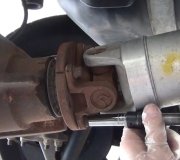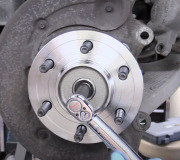Check for Vacuum Leaks
If the vehicle has an abnormal pedal pressure look at the vacuum source first. Look for a bad hose, such as one with holes, is too soft and collapses easily, or has a bad connection on the intake manifold. Correct the problem if found and continue if brake relief is not restored.
If no problem is evident then start the engine and use a pliers and squeeze the hose midway between the engine and the booster and carefully pull the one-way valve out of the booster. Do not loose the rubber grommet in the booster that the one-way valve fits into. The engine will not want to run well if the pliers are released, since it will make a major vacuum leak. Put a finger over the one-way valve end first. Release the pliers and feel if there is good vacuum in the hose or if any leaks can be heard. You will hear a hissing sound if there are leaks.
Check the Booster and Master
If the hose has a good suction and no other leaks are found, clamp the hose once again to slow the vacuum loss and push the one-way valve back into the vacuum booster. Shut the engine off and immediately pull the one-way valve off the booster. If the booster is holding vacuum, you will hear a loud whooshing noise.
If no noise or very little is heard, check the one-way valve to see if it is functioning properly. Hold the valve to your mouth and put suction on one side and then on the other. If air can be sucked through the valve in one direction and not the other the valve is good. If air can be sucked through both sides it is bad and needs to be replaced.
If the valve is good then the booster is bad and needs to be replaced. The reason for the failure could be it is defective or it could have a leaky master cylinder. Look at the mounting surfaces where the master cylinder mounts to the booster. If there is any brake fluid on the booster the master is leaking into the booster and causing deterioration of the diaphragm. Replace the master cylinder as well, for it will ruin the new booster.
If there is no problem found at this point there is no problem with the master or booster. The problem is with the front disc brakes that make the brake pedal hard. The pins that the calipers slide on when the brakes are applied are gunked up or full of corrosion. Remove the caliper and clean the sliders well and smear a little grease on the pins.
Tuesday, August 31st, 2010 AT 9:09 PM


